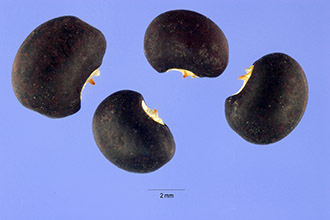American Hogpeanut
Scientific Name: Amphicarpaea bracteata (L.) Fernald

| General Information | |
|---|---|
| Usda Symbol | AMBR2 |
| Group | Dicot |
| Life Cycle | AnnualPerennial, |
| Growth Habits | Forb/herbVine, |
| Native Locations | AMBR2 |
Plant Guide
Alternate Names
Wild peanut
Uses
Ethnobotanic: The hogpeanut was used by many tribes of the Plains as a food source. The Pawnee are reported to have gathered hogpeanut from rat’s nests. The Chippewa used the hogpeanut for a food source, eating the fruit and roots. They also used it as a digestive aid. The Cherokee would spit a tea made from the root of hogpeanut on snakebites and consume the root tea to aid in diarrhea.
Status
Please consult the PLANTS Web site and your State Department of Natural Resources for this plant’s current status (e.g. threatened or endangered species, state noxious status, and wetland indicator values).
Description
General: Bean Family (Fabaceae). American hogpeanut is a taprooted, native, annual. The stems can be smooth or covered with short hairs and coil around a support for climbing (2-20 dm tall). The leaves are alternate, compound and with 3 leaflets. Leaflets are broadly lanceolate to ovate. The leaf stalks (petioles) are 2-10 cm long. The hogpeanut produces two sorts of flowers. The first is an unbranched, elongated inflorescence with pedicellate flowers maturing from the bottom up. These flowers open before fertilization and are usually cross-pollinated (chasmogamous). The other flowers are self-fertilized without opening (cleistogamous) and are produced on creeping branches near the ground. The fruit is a sickle-shaped, thin-walled legume, 4-6 mm long. Distribution: For current distribution, please consult the Plant Profile page for this species on the PLANTS Web site. Habitat: American hogpeanut is found in dry or moist woodlands, along roadsides, and in prairie ravines.
Establishment
American hogpeanut, as a member of the bean family, will fix nitrogen that will benefit plants growing around it, American hogpeanut requires a moist, humus-rich soil, Use soil moisture sensors to measure the soil moisture of American Hogpeanut., To germinate the seeds, pre-soak them for 12 hours in warm water and sow them in the spring in a semi-shaded area,
Pests and Potential Problems
Grown in its native habitat and using a local seed stock the American hogpeanut should not be prone to debilitating pests. Cultivars, Improved, and Selected Materials (and area of origin) These materials are readily available from commercial plant sources.
